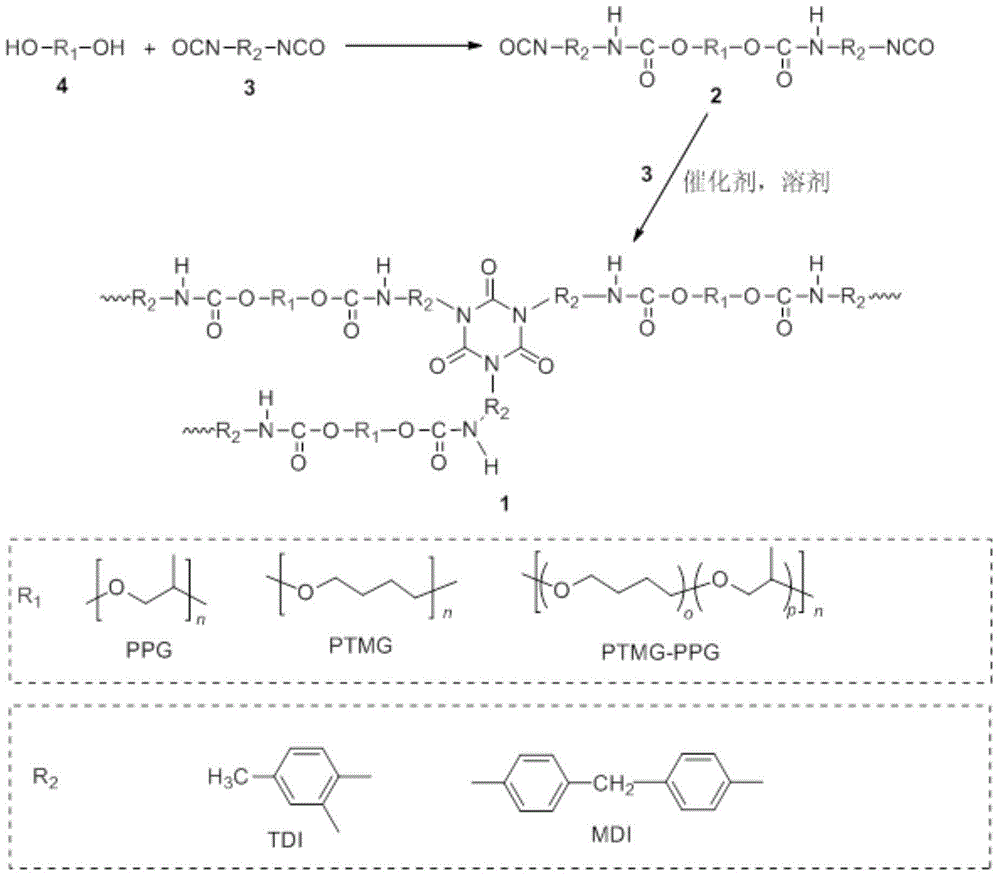Two-step synthetic method of polyurethane modulus gradient material
A technology of gradient modulus and polyurethane, applied in the field of two-step synthesis of polyurethane modulus gradient materials
- Summary
- Abstract
- Description
- Claims
- Application Information
AI Technical Summary
Problems solved by technology
Method used
Image
Examples
Embodiment 1
[0022] Add 200g (0.2mol) of polyoxypropylene glycol (PPG 1000) into a 1000mL three-neck flask, attach a thermometer and a reflux condenser, and dehydrate under reduced pressure at 105°C and a vacuum of 0.1MPa. After 2 hours of dehydration, the temperature began to drop. When the temperature was lower than 70°C, 200 g of acetone and 56 g (0.32 mol) of toluene diisocyanate (TDI) were added, and refluxed for 2.5 hours to obtain a polyurethane prepolymer. Continue to add the TDI of 25.6g (the 10wt% of polyurethane prepolymer) in reaction system, add the N of 2.1g again, the bisphenol A diglycidyl ether of N-dimethyl benzyl amine and 2.1g (catalyst consumption is 1.5 wt%), after reacting at 60°C for 10min, the solution was poured into a polytetrafluoroethylene mold, acetone volatilized and then bulk polymerized. ester-isocyanate), yield 96.8%.
Embodiment 2
[0024] Add 200g (0.2mol) of polyoxypropylene glycol (PPG 1000) into a 1000mL three-neck flask, attach a thermometer and a reflux condenser, and dehydrate under reduced pressure at 105°C and a vacuum of 0.1MPa. After dehydration for 2 hours, the temperature began to drop. When the temperature was lower than 70°C, 200 g of acetone and 59 g (0.34 mol) of toluene diisocyanate (TDI) were added, and refluxed for 3 hours to obtain a polyurethane prepolymer. Continue to add the TDI of 25.9g (the 10wt% of polyurethane prepolymer) in reaction system, add the N of 2.1g again, the bisphenol A diglycidyl ether of N-dimethyl benzyl amine and 2.1g (catalyst consumption is 1.5 wt%), after reacting at 60°C for 10min, the solution was poured into a polytetrafluoroethylene mold, acetone volatilized and then bulk polymerized, the heating conditions were 80°C / 2h+100°C / 2h+120°C / 2h, and finally 273g of poly(ammonia ester-isocyanate), yield 94.3%.
Embodiment 3
[0026] Add 200g (0.2mol) of polyoxypropylene glycol (PPG 1000) into a 1000mL three-neck flask, attach a thermometer and a reflux condenser, and dehydrate under reduced pressure at 105°C and a vacuum of 0.1MPa. After 2 hours of dehydration, the temperature began to drop. When the temperature was lower than 70°C, 200 g of acetone and 62 g (0.36 mol) of toluene diisocyanate (TDI) were added, and refluxed for 4 hours to obtain a polyurethane prepolymer. In the reaction system, continue to add the TDI of 26.2g (10wt% of polyurethane prepolymer), add the N of N, N-dimethyl benzyl amine and the bisphenol A diglycidyl ether of 2.2g again (catalyst consumption is 1.5 wt%), after reacting at 60°C for 10min, the solution was poured into a polytetrafluoroethylene mold, acetone volatilized and then bulk polymerized. ester-isocyanate), yield 97.2%.
PUM
 Login to View More
Login to View More Abstract
Description
Claims
Application Information
 Login to View More
Login to View More - R&D
- Intellectual Property
- Life Sciences
- Materials
- Tech Scout
- Unparalleled Data Quality
- Higher Quality Content
- 60% Fewer Hallucinations
Browse by: Latest US Patents, China's latest patents, Technical Efficacy Thesaurus, Application Domain, Technology Topic, Popular Technical Reports.
© 2025 PatSnap. All rights reserved.Legal|Privacy policy|Modern Slavery Act Transparency Statement|Sitemap|About US| Contact US: help@patsnap.com

